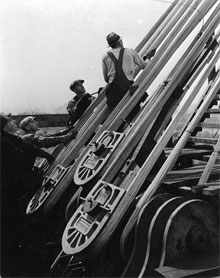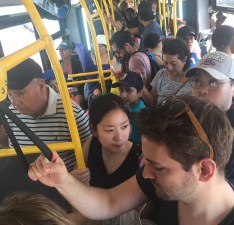Economy Hitting the Skids? Time to Get Ambitious About Transportation
 T.A. director Paul White sends along this little nugget he came across in the New York Times archive. Read it for a timely review (penned by a pre-Bilbao Herbert Muschamp) of a Municipal Art Society show staged the last time an economic downturn coincided with a presidential election, in 1992:
T.A. director Paul White sends along this little nugget he came across in the New York Times archive. Read it for a timely review (penned by a pre-Bilbao Herbert Muschamp) of a Municipal Art Society show staged the last time an economic downturn coincided with a presidential election, in 1992:
"Steel, Stone and Backbone," which runs through Sept. 19, is a
protest against recessionary thinking. It’s a strike against the idea
that in hard economic times people should lower their expectations
about what kind of city they want to live in. In fact, the point of the
show is to offer historical proof to the contrary. When the going gets
tough, the tough get ambitious about architecture. Much of the New York
that is most admired — its water and transportation systems, housing,
cultural institutions — emerged from periods of economic crisis.The
show, put together by Laura Rosen, an archivist with the Triborough
Bridge and Tunnel Authority, offers a look at six of these periods and
the public works they produced. Many viewers will already be familiar
with one of them: the Great Depression and its astounding record in
projects for housing, recreation and transportation. With segments
devoted to such projects as La Guardia Airport, Orchard Beach in the
Bronx and the Queens-Midtown Tunnel (with a video presentation on the
"sand hogs" who built it), the 1930’s takes up most of the exhibition
space.But the real news of the show is that the building boom
of the 30’s wasn’t the exception. It was the rule. Such booms have
frequently coincided with financial busts, or as they were termed in
the 19th century, "panics." The Panic of 1837 saw the building of the
Croton Water System, including the monumental Egyptian Revival
reservoir that used to stand on the current site of the New York Public
Library. After the Panics of 1873 and 1893, work began on the
Metropolitan Museum of Art, the American Museum of Natural History and
the New York Zoological Society, later known as the Bronx Zoo. What a
panic.
If the 1930s saw the completion of ambitious projects ushering in an age of cheap air travel and mass car commuting, might the near future see a transit renaissance and the mainstream emergence of non-motorized transport?
With municipal budgets reeling, a big question mark is where the money would come from. A national infrastructure bank? Carbon taxes and congestion pricing? Bill Gates and Warren Buffett? "History doesn’t hand us a key," says Muschamp in his MAS review. "However, the implicit message of this show is that we will have to invent one for ourselves."
Photo of workers anchoring wire cables on the Triborough Bridge: New Deal Network
